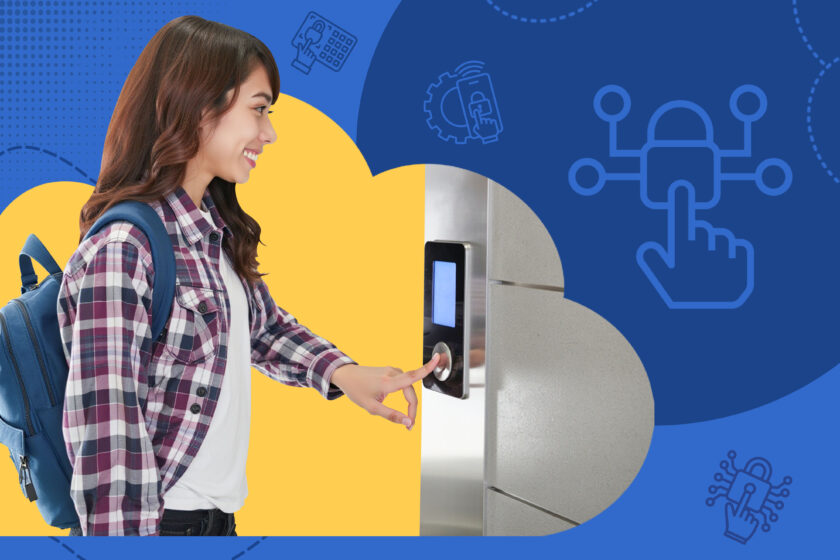The growing frequency of security breaches is urging businesses to reconsider how they protect their premises. In today’s world, ensuring controlled access to your premises is more important than ever. With rising threats and evolving risks, protecting your business and assets starts with understanding and implementing robust security measures. Among the diverse tech-based safety solutions available today, the door access control system stands as the right choice. This robust security system not only protects your premises but also offers an effective and streamlined method for managing people’s movement in your building.
What is a Door Access System?
A door access system is a digital solution designed to manage the entry and exit of people in specific areas of a building. Rather than employing traditional keys, these systems utilize electronic technologies such as key cards, PINs, fingerprint scans, or facial recognition to permit or block entry.
The system functions by verifying an individual’s credentials against a stored database. A successful match opens the door and if it not, access is denied. This ensures sensitive areas remain protected and only authorized people can enter. Moreover, beyond just having control over the door access, these systems extend to serve several other vital information. They provide data such as attendance tracking, overseeing the visitors, real-time entry logs, and integration with HR systems. Thus, you can manage and view every action and operation in your workplace. It gives a complete overview of the people’s movement within the premises, adding an extra layer of safety and accountability.
How Does a Door Access Control System Work?
A door access control system for businesses operates through three essential steps: identification, authentication, and authorization.
- Identification: Initially, the system observes the person trying to gain access. This process may involve using a key card, entering a PIN, or performing a biometric scan.
- Authentication: The system then gains the user identity input to verify their biometric data, like matching their face or fingerprint to the data stored in the system.
- Authorization: The system verifies if the entity is authorized to access the location or resource. Upon authentication, entry is permitted. When all conditions are checked, the door unlocks automatically. When all conditions are checked, the door unlocks automatically.
Why Do Businesses Use Door Access Control Systems?
More and more companies are choosing to adopt business access control systems to create safer workplaces and stay better organized. From easily tracking employee movements to strengthening overall security, here are the key reasons behind the switch:
Improved Security: These systems ensure that only authorised individuals can enter sensitive areas like server rooms or restricted office spaces. It helps reduce the risk of theft, data breaches, or unauthorised access.
Elimination of Physical Keys: The era of carrying around bulky keys is over. With an electronic system, you can efficiently modify or revoke access credentials, eliminating the need to change physical locks when employees leave or misplace keys.
Real-Time Monitoring and Accountability: Access control systems enable real-time tracking of entries and exits, giving businesses instant visibility into who is accessing what areas and when. This is crucial for both security and operational control.
Attendance Tracking: Biometric access methods like fingerprints & facial recognition can be linked directly to time attendance software. This helps to automatically record attendance, track lateness and overtime while streamlining payroll accuracy.
Customizable Permissions: You control who gets access to specific areas and when. For instance, sensitive zones can be limited to certain departments, or access can be restricted based on roles, where everything is managed with ease.
Common Use Cases of Door Access Control Systems
Door access control systems are highly adaptable and used across various industries. Here’s how they are applied in different sectors:
Corporate Offices: In a corporate environment, access control systems reinforce department-level security and automate attendance tracking. Data Sensitive departments like HR and finance benefit from this added protection.
Warehouses: Access control systems in warehouses help secure goods and monitor staff access to specific zones. This reduces the risk of theft and ensures sensitive inventory is managed responsibly.
Healthcare Centers: High security measures need to be maintained for patient records and pharmaceutical storage items. Sensitive personal data related to the patient and controlled drugs needs a highly protective system. Access control system ensure that only authorized medical staff can enter restricted areas, while protecting both people and information.
Learning Institutions: Educational institutions require high security measures for exam materials and staff-only spaces. Access control systems are essential solutions to safeguard these areas and ensure that only authorized individuals can gain access.
Government Buildings: High-security environments, such as government offices or facilities, rely on access control to manage who can enter various sections, enhancing both physical and information security.
Final Thoughts
In today’s fast-moving work environments, balancing security with convenience is key, and door access control system strike that balance perfectly. They are more than just tools for security; they’re part of a smarter way to operate any workspace. With features like real-time access logs, integration with attendance systems, and customizable access levels, these systems take a load off your HR and operations team by automating operations and reducing manual work.
They eliminate the need for manual sign-ins, making it easier to manage people flow and access permissions. But most importantly, they help your employees feel safe and valued. It shows you care enough to invest in solutions that protect both people and assets. In a time when digital transformation is reshaping the way we work, having a modern access system isn’t just convenient—it’s essential. It’s about future-proofing your workplace and fostering a culture of trust, security, and efficiency.
Book a free demo today and see how a secure, seamless access system can transform your workplace.

